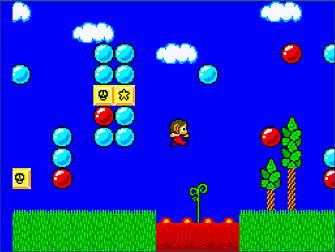 ... ...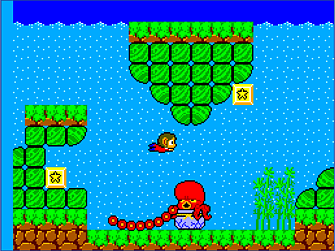
Those who follow this site somewhat-regularly might be aware that I have what some would consider to be an irrational hatred of Alex Kidd. I'm not usually the type to arbitrarily hate videogame characters, but my first experience with Sega's defunct mascot in High-Tech World was one of the most unpleasant gaming experiences of my life. Willing to give the series another chance as even hardcore fans often regard that entry as the worst, I gave Miracle World a try. Once again, I was assaulted by bland visuals, annoying music, Alex Kidd's ridiculously-robotic walking animation and stupid-looking head, flat level design, and play control so bad that I gave up at about the halfway point and couldn't go back to it for awhile. Recently, I decided to give it another chance, hoping that the appeal of Alex Kidd would eventually infect me. I can't say that it did, although I was able to finally complete the game.
The biggest problem I had with acclimating to the controls is that the buttons for jumping and attacking are reversed. I'm not even sure if I realized that's what was wrong with them, but I knew something was extremely awkward. Eventually, I got so used to the controls that I ended up blowing through the entire game with relative ease, whereas I had been struggling before. Even with my brain having finally accepted the backwards nature of them, the control is still plagued with hit detection and momentum problems. You can punch at an enemy with Alex's really huge fist, but if you don't connect exactly right, the fist will go right through the enemy and you might even take a hit instead. Alex also skids around like Master Higgins in the Adventure Island games, making it hard to control him after landing from a jump or just running a few steps. Stages are designed so that you are likely to jump and then slide off or overshoot your landing point onto a bed of spikes or other life-depriving obstacle.
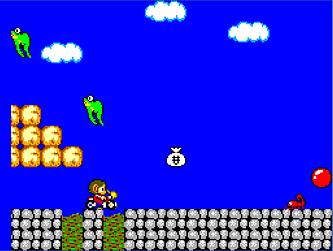 ... ...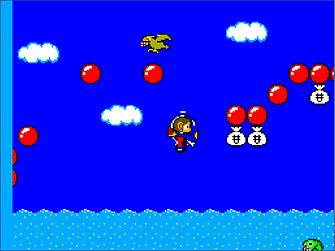
I'm almost inclined to believe the control was made awkward on purpose to encourage you to find other means of getting through the levels. Sure enough, Alex Kidd can ride vehicles such as a motorcycle and helicopter in some stages that make clearing them less of a chore. This, I imagine, is some of the appeal of this game as they do provide a little diversion from the normal running, jumping, and punching. However, the vehicles don't make the game great so much as they make levels that would otherwise be unbearable more tolerable. There are also other items you can acquire by collecting enough moneybags. The idea of collecting enough lives and stuff in early levels so you can survive later seems to be a Sega platformer staple, as it's true of Sonic the Hedgehog and Sonic 2, and it's present here, too.
Also part of the appeal, I imagine, is that Miracle World contains some distinct Japanese elements: rice balls, yen symbols on the moneybags, and a hero who resembles Son Goku. Unfortunately, they're only minor distractions from the otherwise generic backgrounds and boring enemy designs. The Sega Master System supposedly has better graphics capabilities than the NES, but I've yet to see a game that could've made that apparent without knowledge of the system specs. I have seen fans perplexed that Sega has not made an Alex Kidd game in years, but I don't think it's difficult at all to see why he was retired. Aside from the shaky quality of the games, the franchise exudes a "babyish" persona, and while I'm hard-pressed to determine what exactly makes characters like Sonic and Tails more "mature" than Mario, Alex Kidd clearly did not project the image they wanted.
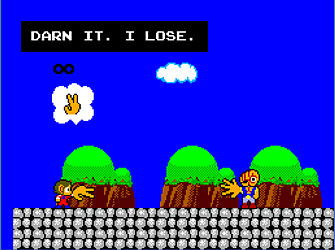 ... ...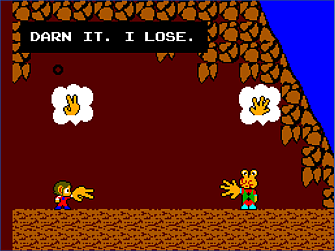
While I'm now hestitant to say Miracle World is worse than High-Tech World, it managed to commit an even more atrocious crime than the bizarre instant deaths - bosses fought by playing games of "Rock-Paper-Scissors" (called "Janken" matches) that take far too long to play out. Yes. I'm serious. If forced to choose what is the single worst idea for a boss fight ever, this would be it. Although some of the bosses telegraph their moves in a thought bubble so you can try to beat them legitimately, some of them don't, and the last one cheats. You have two choices for dealing with this: You can look up a FAQ for the right pattern to use against these guys, or you can play the game over and over again while trying to figure out the pattern on your own. I didn't have enough patience for the latter.
Miracle World feels long, if only because there is no indication of when it will end. The map shown between levels has no marked pathways and no destination points, so you have no idea how many of those places Alex Kidd will visit, and the difficulty of the stages never significantly increases. Although the last stage (a room-by-room obstacle course of a castle) is long, by the time I got that far, I was adjusted to the controls enough to quickly plow through it. Along with the platforming and vehicle-riding, the game has one puzzle that you must solve if you want to beat it proper and see the ending - a blank screen of scrolling text. I could complain about that more, except that by then, I was just glad the game was over.
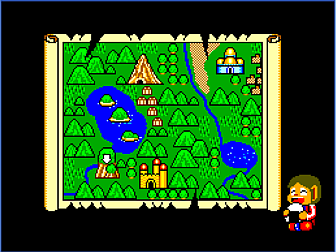 ... ...
I may not truly hate the character or the game as much as I once did - it is marginally better than High-Tech World. But despite the variety in stage designs, they seem to merely exist instead of congealing into something greater than the sum of its parts. Indeed, if there is still any greatness to be found in the Alex Kidd series, it will take something far more miraculous than Miracle World to enlighten me.
Score: 1.5/5
|